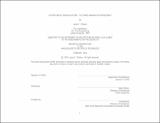| dc.contributor.advisor | Nader Tehrani. | en_US |
| dc.contributor.author | O'Koren, Jason F | en_US |
| dc.contributor.other | Massachusetts Institute of Technology. Dept. of Architecture. | en_US |
| dc.coverage.spatial | n-us-ny | en_US |
| dc.date.accessioned | 2010-08-26T15:17:23Z | |
| dc.date.available | 2010-08-26T15:17:23Z | |
| dc.date.copyright | 2010 | en_US |
| dc.date.issued | 2010 | en_US |
| dc.identifier.uri | http://hdl.handle.net/1721.1/57528 | |
| dc.description | Thesis (M. Arch.)--Massachusetts Institute of Technology, Dept. of Architecture, 2010. | en_US |
| dc.description | This electronic version was submitted by the student author. The certified thesis is available in the Institute Archives and Special Collections. | en_US |
| dc.description | Cataloged from student submitted PDF version of thesis. | en_US |
| dc.description | Includes bibliographical references (p. 127). | en_US |
| dc.description.abstract | Urban Infrastructure: bridges, expressways, and on and off ramps often create barriers and uninhabitable spaces within the urban context. This phenomenon is evident in northern Manhattan where the Trans-Manhattan Expressway has imposed profound divisions within the dense urban community of Washington Heights. Supporting a population of over one-hundred thousand, in 0.7 square miles, Washington Heights is one of the densest residential communities in Manhattan. Within this dense community no identifiable civic centers exist. However, the convergence of infrastructure and urbanism has the potential to synthesis new opportunities. This contemporary paradigm morphs existing infrastructure with new user-friendly architectural systems. This hybridization can alleviate the current asphyxiation associated with urban infrastructure, while transforming infrastructure to serve as a catalyst for urban life. This thesis seeks to readapt the Trans-Manhattan Expressway for public use through two strategic interventions. The first seeks to reclaim the colossal George Washington Bridge Bus Terminal from impervious infrastructure to central civic icon. The second transforms a series of urban impediments which produce excess noise and pollution, into a public plaza. While these two projects address the independent conditions of each site, together they simultaneously transform a desolate lineage of urban infrastructure into the central civic icon of Washington Heights. | en_US |
| dc.description.statementofresponsibility | by Jason F. O'Koren. | en_US |
| dc.format.extent | 127 p. | en_US |
| dc.language.iso | eng | en_US |
| dc.publisher | Massachusetts Institute of Technology | en_US |
| dc.rights | M.I.T. theses are protected by
copyright. They may be viewed from this source for any purpose, but
reproduction or distribution in any format is prohibited without written
permission. See provided URL for inquiries about permission. | en_US |
| dc.rights.uri | http://dspace.mit.edu/handle/1721.1/7582 | en_US |
| dc.subject | Architecture. | en_US |
| dc.title | Opportunistic infrastructure : the Trans-Manhattan Expressway | en_US |
| dc.title.alternative | Trans-Manhattan Expressway | en_US |
| dc.type | Thesis | en_US |
| dc.description.degree | M.Arch. | en_US |
| dc.contributor.department | Massachusetts Institute of Technology. Department of Architecture | |
| dc.identifier.oclc | 630606352 | en_US |
